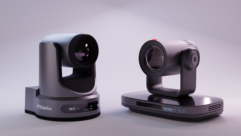
Moving to HD Videoconferencing
Apr 1, 2008 12:00 PM,
By Jay Ankeney
As broadcast evolves into high-end HD, conferencing systems are following close behind.

The Cisco CTS 3000 is a telepresence system that features 12 seats at the virtual table through three 65in. plasma screens.
Although the perception of high definition is in the eye of the beholder, HD has rapidly become associated by most people as the highest level of video presentation commonly available today. In reality, many applications — especially in the medical and scientific field — are already reaching far beyond the resolution of HD, and professional postproduction editors who are working in the 2K realm to approach film resolutions consider HD to be a scratch track, or “offline” resolution used for down-and-dirty editorial decision making.
When the Advanced Television Systems Committee (ATSC) was asked to come up with standards to support the FCC mandate for domestic broadcasters to change over to digital broadcasting by an end date of Feb. 17, 2009, they came up with 18 or 36 formats for HD television, depending on how they are measured. The only points they share are that the HD image for broadcasters has to be widescreen (16:9), and it must be encoded using MPEG-2.
The two HD formats most widely adopted have been 720p (1280×720) scanned progressively 60 times a second, and 1080i (1920×1080) with an interlaced scan also at 60Hz. In the United States, 720p has been adopted by Fox, ABC, and ESPN, among others. 1080i proponents include NBC, CBS, CNN, and HBO.
It is important to note that the FCC mandate is for digital broadcasting, not specifically HD, and many networks are already drooling over the potential of dividing their newly allocated 6MHz digital channels into several 4:3 standard-definition programming streams. That would give them untapped potential for narrow-casting up to six specialized programming channels over that single government-guaranteed part of the frequency spectrum.
However, videoconferencing systems are not constrained by FCC regulations, and the term “HD” has become such an enticing sales tool that many companies are playing loosely with the definition of the high-definition signals they are sending to their screens. Although it is generally agreed that the ubiquitous term “telepresence” (used for the most immersive videoconferencing installations) should rely upon reality-emulating HD images, many systems are using lower frame rates than broadcasters. So although an advertised 720p system may indeed have 1280×720 pixels on the screen, they may be presented as low as 15fps to save on bandwidth.
There are even some companies presenting images in 1080p, which is 1920×1080 scanned progressively. It takes a very golden eye to tell the difference between 1080i and 1080p when presenting human faces, but the difference may pay off in graphic details or CAD drawings — and it is always good to shoot for the highest possible quality if your bandwidth can support it. Because the European Union is considering standardizing on 1080p for terrestrial HD transmission, this format may just be coming into its own.
Moving to HD Videoconferencing
Apr 1, 2008 12:00 PM,
By Jay Ankeney
As broadcast evolves into high-end HD, conferencing systems are following close behind.
PRACTICAL HD
For the videoconferencing industry, HD first became practical when their designers were presented with a genie that keeps on giving called the H.264 video-compression standard. Completed in May 2003, H.264 is the result of a partnership effort between the International Telecommunication Union-Telecommunication (ITU-T) Video Coding Experts Group and the International Organization for Standardization/International Electrotechnical Commission Moving Picture Experts Group (MPEG), which became known as the Joint Video Team. H.264 is also called MPEG-4 Part 10 or AVC (for Advanced Video Coding), but its greatest benefit is that it leapfrogs over a broadcaster’s required compression technology by requiring up to half the amount of MPEG-2 bandwidth to transmit an HD signal. With lots of other goodies built in, such as 16 reference frames and variable block-size motion compensation, H.264 simply gives you more for less.
Its implementation can be attributed to many people, but most prominently among them is Craig Malloy, who, in 1994, was working for VTEL in Texas trying to produce videoconferencing add-in cards for PCs. Malloy saw that the 486 processors of the time simply did not have the computer power for distant realtime video collaboration. So Malloy founded ViaVideo and produced the ViewStation as a dedicated integrated videoconferencing desktop system based on the then-new H.263 codec that had been developed by the ITU for transmitting low-bit-rate compressed video. When ViaVideo was purchased by Polycom in 1998, its ViewStation was still in the Model T stage, but at least it worked well enough for Malloy to head up Polycom videoconferencing efforts.
Five years later, Malloy recognized that the Internet’s bandwidth had improved enough to be taken seriously, and because H.264 had just been standardized with a significant compression performance improvement, he left Polycom to found LifeSize Communications. He discovered that even 1280×720 progressively scanned high-definition video at 30fps could be sent over the public Internet using only 1Mbps of bandwidth.
In 2005, LifeSize brought out the first videoconferencing system that could claim to use high-def images. It was called LifeSize Room, and it was integrated with the company’s LifeSize Phone, a super- wideband audio system built around 16 directional microphones that could also be used as a powerful standalone conference phone.
But even today, LifeSize is not incorporating a flavor of HD that broadcasters would acknowledge as being high definition.
WHAT’S NEW
This year, however, Sony has crossed that threshold. Its new PCS-XG80 system combines 1080i resolution and a high frame rate of 60 fields per second to deliver superb live video quality, providing a comfortable alternative to face-to-face meetings. As an expansion of Sony’s HD videoconferencing family of systems, the new PCS-XG80 includes many features of the company’s successful 720p-capable PCS-HG90 system released last year.
The PCS-XG80 system will be introduced at InfoComm in June, and it will be available through Spire Global, which serves as Sony Electronics’ sales and service arm for its Ipela line of IP-based videoconferencing endpoints and accessory products. The PCS-XG80 can also connect at HD video quality with legacy standard-definition systems.
To step up one more level of image density, Cisco Systems has its CTS 3000 TelePresence 1080p/60 videoconferencing system. Although 1080p is often called “full HD” in marketing-speak for home theaters, 1080p takes considerably more bandwidth to run than other data-intensive imaging systems — even when employing the H.264 codec. But then again, Cisco is in the bandwidth business, so the company can make sure the Cisco TelePresence system will get the throughput that it needs.
Thanks to its 1080p high-definition capabilities, the Cisco TelePresence videoconferencing system provides twice the image detail of any other remote AV communications application designed for business collaboration.
But don’t think that level of detail is the limit. The Japanese Ministry of Internal Affairs and Communications has already started a public-private partnership to develop Ultra High Definition Video (UHDV) at 7680×4320 for a total of 16 times the pixel resolution of the current forms of HD (what some people would refer to as 8K imagery). UHDV is also designed to be accompanied by 22 channels of sound and two subwoofers.
Ultra High Definition Video was first demonstrated at World Exposition 2005 in Aichi, Japan, and it made a spectacular appearance in a special pavilion at the 2007 NAB convention in Las Vegas. Japanese broadcaster NHK has demonstrated a live relay of a UHDV (what it calls “Super Hi-Vision”) program over a distance of 162 miles by a fiber-optic network. Using dense wavelength-division multiplexing, 24Gbps speed was achieved with a total of 16 different wavelength signals. From a broadcast point of view, the system is still embryonic, and NHK is reported to be years away from developing a method of recording 8K imagery, but development is well underway.
Is that in the future of video teleconferencing? There are, after all, plenty of numbers left to follow the “dot” after “H” in the next generation of compression codecs — and the Internet, as well as private corporate networks, is getting more robust every year.
FOR MORE INFORMATION
Advanced Television Systems Committee
www.atsc.org
International Telecommunication Union
www.itu.int/net
Polycom
www.polycom.com
Sony
www.sony.com/videoconferencing
Cisco
www.cisco.com
Jay Ankeneyis a writer and video consultant in the Los Angeles area who has worked in professional film/TV for several decades.










